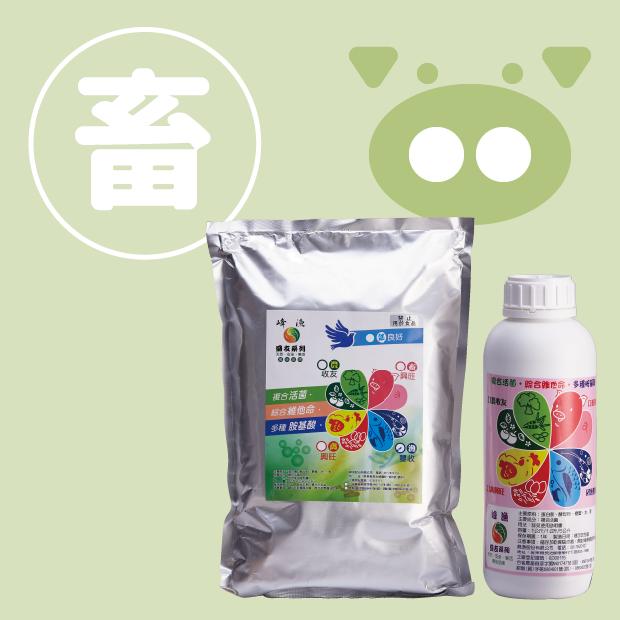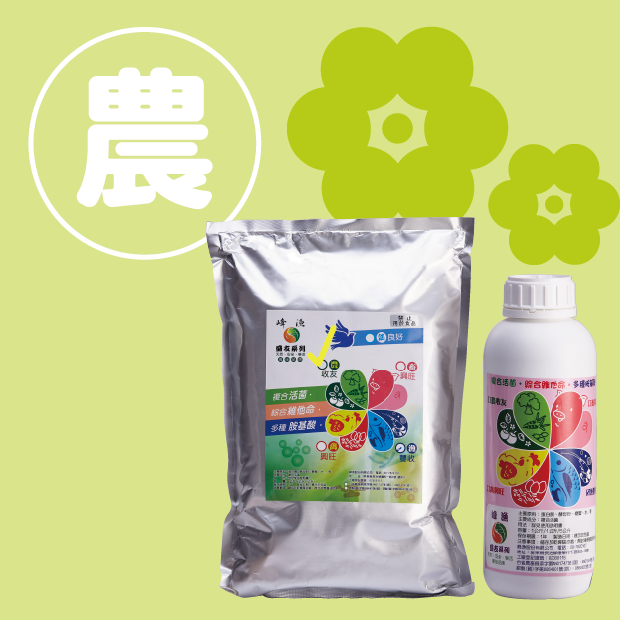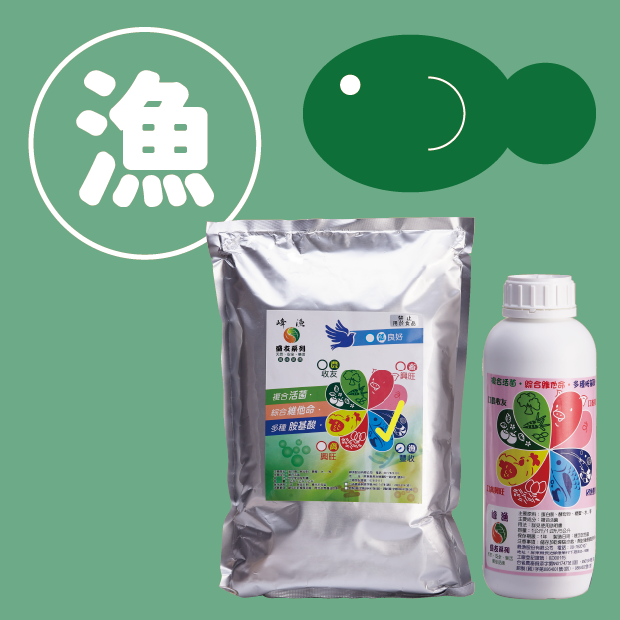All PRODUCTS
-
Read More
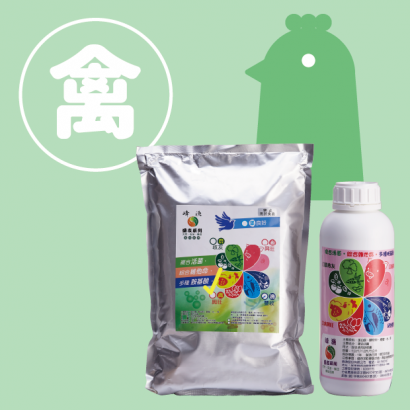 Specifically for the poultry-Microbial nutrient
Specifically for the poultry-Microbial nutrientSpecifically for the poultry-Microbial nutrient
Product Features
High bacterial count: This probiotic uses new biotechnology to maintain high bacterial count and activity
Stability: Under the action of symbiosis, viable bacteria have the ability to self-regulate, which can prolong the shelf life, and have considerable resistance to subsequent processing processes (such as granulation and drying) under harsh conditions.
Strong antibacterial ability: This probiotic has a certain inhibitory ability to bad bacteria. Escherichia coli inhibition 95%, Salmonella 93.8%.
Specificity: Viable bacteria is developed as a general product, not specific to a specific variety.
Wide range of use: can function in the natural environment H2.5-pH11 range, and can cooperate with subsequent reprocessing process.
Pure natural: pure natural food-grade substrate fermentation, no artificial chemicals (including antibiotics, hormones, growth hormones) are added, and no side effects for prolonged use.
Decomposition power: It has strong decomposition power, and has the comprehensive effect of synthesis, oxidation and reduction, and produces a large number of decomposing enzymes. (Protein/Fat/Payment/Amylolytic enzyme)
Sensitivity: Screen for strains that are resistant to antibiotics, and have certain resistance to environmental changes under the symbiosis of live bacteria.
Adhesion: live bacteria are screened from the gastrointestinal tract of animals, and have a strong force on the intestine.
Main microbiota
Yeasts : With a special flavor to improve animal appetite, increased appetite and resolve flatulence. Promote the growth of intestinal villi expel harmful bacteria on flagellum to maintain intestinal health.
Lactobacillus: After fermentation, it produces large amounts of lactic acid, acetic acid, organic acids that inhibit intestinal pathogens, and regulates the pH value of the intestine and the balance of bacteria in the animal intestine. Through nutrient competition or secretion of antibiotics and bacteriocin, it inhibits pathogenic microorganisms, regulates the immune activity of intestinal mucosa, and improves the survival rate of disease erosion.
Bacillus subtilis : It secretes a variety of natural enzymes, such as protein fat/carbohydrate/amylase, etc., to convert macromolecular organic compounds with high carbon content into small molecular organic compounds, so that the feed can be decomposed first and the nutrients are completely absorbed.
Photosynthetic bacteria : All life on earth depends on photosynthesis, and the evolution of photosynthesis started from an autotrophic anaerobic prokaryotic organism that can use light energy as an energy source, all of which are photosynthetic bacteria. Photosynthetic bacteria are rich in protein, vitamin B group, bacteriochlorin and carotenoids, and have the ability to fix helium and purify water. Rich in multi-vitamin、amino acids and bacteriochlorins, It has the ability of solid helium and water purification. In terms of bait for production animals As animal feed,, it is rich in protein, vitamins and growth-promoting factors , Aafter animals absorbing photosynthetic bacteria, animals can significantly improve disease increase resistance, promote growth, and shorten the feeding time and reduce costs.
-
Read More
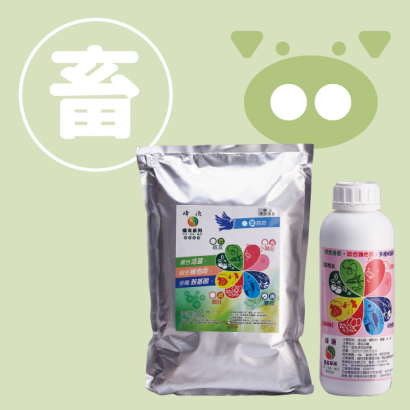 Specifically for the livestock-viable bacteria nutrient
Specifically for the livestock-viable bacteria nutrientSpecifically for the livestock-viable bacteria nutrient
Product Features
High bacterial count: High-tech biotechnology is used to maintain high bacterial count and activity.
Pure natural: pure natural food-grade substrate fermentation, no artificial chemicals (including antibiotics, hormones, growth hormones) are added, and.no side effects for prolonged use.
Strong decomposing power: It has the comprehensive effect of synthesis, oxidation and reduction, and can produce a large amount of decomposing enzymes (proteolytic enzymes, lipolytic enzymes, amylolytic enzymes, and fibrinolytic enzymes).
Sensitivity: Screen for strains that are resistant to antibiotics, and have certain resistance to the environment under symbiotic action.
Specificity: Viable bacteria is developed as a broad-spectrum product, not targeting specific species.
Strong antibacterial ability: This probiotic has a certain inhibitory ability to bad bacteria. Escherichia coli inhibition 95%, Salmonella 93.8%.
Stability: Symbiosis, viable bacteria have the ability to adjust spontaneously, prolong the shelf life, and have certain resistance to subsequent processing under harsh conditions (such as granulation, drying).
Wide range of use: It can add 2.5-pH11 in the natural environment, and can cooperate with the subsequent reprocessing process.
Adhesion: Viable bacteria are screened from the gastrointestinal tract of animals, and have good adhesion to the intestinal tract.
Main microflora
Yeasts: With a special flavor to improve animal appetite, increased food intake and resolve flatulence. Promote the growth of intestinal villi and expel harmful bacteria on flagellum to maintain intestinal health.
Lactobacillus: After fermentation, it produces large amounts of lactic acid, acetic acid, organic acids that inhibit intestinal pathogens, and regulates the pH value of the intestine and the balance of bacteria in the animal intestine. Through nutrient competition or secretion of antibiotics and bacteriocin, it inhibits pathogenic microorganisms, regulates the immune activity of intestinal mucosa, and improves the survival rate of disease erosion.
Bacillus subtilis: Bacillus natto is a powerful strain that is not afraid of gastric acid and bile salts, and can effectively enter the intestinal tract to inhibit harmful bacteria. In addition, Bacillus natto can secrete a variety of natural enzymes, such as proteolytic enzymes, lipolytic enzymes, vitamin decomposing enzymes, amylolytic enzymes, etc., which can saccharify macromolecular organic compounds with high carbon content into small molecular organic compounds. It is decomposed first, and the nutrients are completely absorbed.
Bacillus subtilis : Secrete a variety of enzymes , such as proteolytic enzymes, lipolytic enzymes, cellulolytic enzymes, amylolytic enzymes, etc., convert macromolecular organic compounds into small molecules, so that soil nutrients (organic matter) can be decomposed, increase the decomposition and enhance nutrient uptake efficiency.
Photosynthetic bacteria : All life on earth depends on photosynthesis, and the evolution of photosynthesis started from an autotrophic anaerobic prokaryotic organism that can use light energy as an energy source, all of which are photosynthetic bacteria. Photosynthetic bacteria are rich in protein, vitamin B group, bacteriochlorin and carotenoids, and have the ability to fix helium and purify water. As animal feed, it is rich in protein, vitamins and growth-promoting factors After absorbing photosynthetic bacteria, animals can significantly improve disease resistance, promote growth, shorten feeding time and reduce costs.
-
Read More
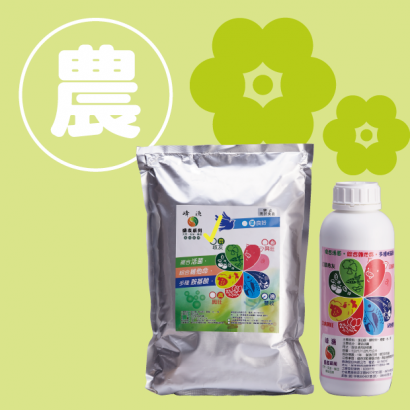 Specifically for agriculture-viable bacteria nutrient
Specifically for agriculture-viable bacteria nutrientSpecifically for agriculture-viable bacteria nutrient
Product Features
Adhere to the fermentation of natural agricultural products, without pesticides, fertilizers, growth hormones and other harmful chemical ingredients.
The high-tech products developed for agricultural cultivation, through special symbiotic culture, enable all strains to produce their individual strongest effects, and increase stability and broad efficacy.
Decomposition toxic ingredients: It decomposes the toxic substances that cause soil acidification due to long-term cultivation, and further restores it to the nutrients needed by plants, reducing the obstacles to continuous cropping and effectively reducing the use rate and residues of pesticides.
Improve soil quality:Improve soil physical properties, make the soil soft, increase soil fertility, water retention and aeration, which is conducive to the development of plant roots and absorption of nutrients.
Beneficial to root development:Established advantages of roots to compete with pathogens for living space and adjusts soil quality.
Decomposition of organic substances and promote the absorption efficiency:Directly supplement the nutrients required for growth or accelerate the decomposition and absorption of organic bases, thereby improving the taste, appearance, uniformity, sweetness and nutritional content of crops.
Increase the resistance to cold damage and environmental change:The cuticle on the leaf surface of the plant increases the tolerance of the plant to the environment.
Main microflora
Yeasts: Using root exudates and soil organic matter, amino acids and sugars produced by photosynthetic bacteria, synthetic substances beneficial to crops , promote root growth and cell division , promote the proliferation of other beneficial microorganisms.
Lactobacillus: Can survive at lower pH values. Lactic acid bacteria use sugars produced by photosynthetic bacteria and yeast to produce strong. Produce powerful bactericidal. Inhibition of fertility and motility of pathogens. Reduce incidence of diseases. The full and complete decomposition of organic matter into nutrients available. Promote germination of seeds and rhizomes.
Bacillus natto (include bacitracin): Secrete a variety of enzymes, such as proteolytic enzymes, lipolytic enzymes, cellulolytic enzymes, amylolytic enzymes, etc., to convert macromolecular organic compounds into small molecules , Increase the decomposition and enhance plant nutrient uptake efficiency.
Photosynthetic bacteria: Substances produced by root exudates or decomposition of organic matter are used as substrates for glucose and amino acids.. Improve fruit sweetness, color, yield, etc. Removal of root around dioxide, carbon monoxide, methane and other harmful substances. Increase the absorption capacity of root hairs. Increase the resistance to harsh environments.
Actinomycetes :
Super parasitism. Make pathogens structure is destroyed or even death.
Competes with pathogens for nutrients, inhibits pathogen survival, and indirectly protects crops.
Secreted metabolites to inhibit pathogens. Substances with larger decomposable molecules can be added to the organic matter to promote the growth of actinomycetes and also help to eliminate continuous cropping obstacles. Mainly, chitinase can decompose the chitin cell wall of fungi, and antibiotics also have an inhibitory effect on bacteria.
-
Read More
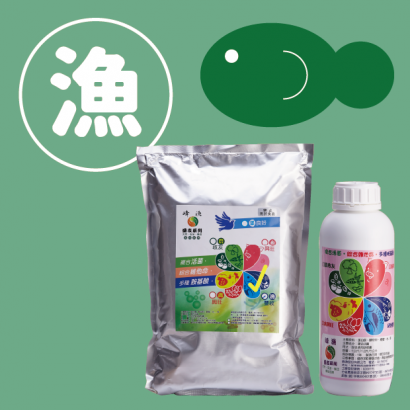 Specifically for aquaculture-viable bacteria nutrient
Specifically for aquaculture-viable bacteria nutrientSpecifically for aquaculture-viable bacteria nutrient
Product Features
Increase feed utilization: convert macromolecular nutrients in feed into small molecules, that will increase nutrient absorption. The viable bacteria can also be used as feed for larval fish and juvenile prawns, increasing their growth rate and survival rate.
Reduce odor and improve meat quality: viable bacteria can effectively eliminate sulfur and nitrogen components in water, so that odor is reduced. When the water quality is better, the meat quality will also improve.
Strong antibacterial ability: This probiotic has a certain inhibitory ability to bad bacteria. Escherichia coli inhibition 95%, Salmonella 93.8%.
Slow down changes in water quality and reduce stress factors: live bacteria decompose and utilize organic matter in water to control the concentration of algae,, and prevent the growth of harmful pathogenic microorganisms and parasites when planktonic algae die in large numbers. It can convert ammonia waste from aquatic organisms into amino acids that can be used, and remove ammonia nitrogen waste from water.
Sensitivity: After actually passing the aquatic gastrointestinal tract and screening strains with strong resistance to antibiotics, under the symbiosis of live bacteria, they have certain resistance to environmental changes.
Reduce the incidence and mortality of diseases: The establishment of an ecosystem of beneficial bacteria in the aquatic environment can effectively inhibit the reproduction of bad bacteria and harmful microorganisms, and reduce the disease rate of aquatic organisms.
Main microflora
Yeasts:Mainly acts on the intestinal tract of the organism, promotes the proliferation and maturation of the villi of intestinal epithelial cells, improves the digestion and absorption of nutrients, and promotes the production of immunoglobulins in the intestinal mucosa, forming a line of defense to resist pathogens. The oligosaccharide structure on the cell surface of yeast itself can also adsorb bacteria with flagella, which will bind the pathogenic bacteria to the yeast cell wall and then excrete it from the body. Inability to form colonies, thereby promoting intestinal flora balance.
Bacillus subtilis: Secrete a variety of enzymes, such as proteolytic enzymes, lipolytic enzymes, vitamin decomposing enzymes, amylolytic enzymes, etc., convert macromolecular organic compounds with high carbon content into small molecular organic compounds, increase the decomposition and enhance nutrient uptake efficiency.
Lactobacillus:Produce large amounts of lactic acid, acetic acid, organic acids, etc. Inhibition of intestinal pathogens. Adjusting the pH of the intestinal tract. Adjust the balance of intestinal microbial communities. Increase resistance. Reduce nitrite content. The formation of dominant microbial population in the soil ponds. Inhibiting pathogenic bacteria reproduction.
Photosynthetic bacteria : All life on earth depends on photosynthesis, and the evolution of photosynthesis started from an autotrophic anaerobic prokaryotic organism that can use light energy as an energy source, all of which are photosynthetic bacteria. Photosynthetic bacteria are rich in protein, vitamin B, bacteriochlorin and carotenoids, which can reduce ammonia, nitrogen, biological oxygen demand (BOD) and increase dissolved oxygen and other water purification capabilities.
-
Read More
 Specifically for pigeon - viable bacteria nutrient
Specifically for pigeon - viable bacteria nutrientSpecifically for pigeon - viable bacteria nutrient
Pigeons are susceptible to environmental changes and diseases due to bacteria. The viable nutrient solves the common problems of rearing pigeons. And also make pigeons stronger and efficient feed conversion, long-term use can reduce the cost of drugs and nutritional products. , in exchange for a healthier and more efficient feeding.
Research and development technology of viable bacteria for pigeons
Safe and stable strains of high-tech symbiotic culture
Contains a variety of probiotics (lactic acid bacteria, yeast, natto bacteria, photosynthetic bacteria, etc.)
A variety of natural enzymes through natural secretion.
A variety of natural nutrition sources and many other technologies
Features of viable bacteria for pigeons
Increase resistance
Increase feed utilization
Ddecomposing excrement, and reducing odor, etc.
-
Read MoreMultiple Vibrio detecting kit
Multiple Vibrio detecting kit
Only need to use 1 tube at a time, and the attached information photo shows 2 tubes at the same time just for the convenience of color comparison.
When the color appears only at the bottom of the tube, flip the tube over and flick it twice.
If the color spreads to the whole tube, and the longer the incubation time, the deeper the color becomes, it can be interpreted as a positive reaction.
Detectable disease species of ornamental fish.
-
Read MoreLactococcus garvieae detecting kit
Lactococcus garvieae detecting kit
Only need to use 1 tube at a time, and the attached information photo shows 2 tubes at the same time just for the convenience of color comparison.
When the color appears only at the bottom of the tube, flip the tube over and flick it twice.
If the color spreads to the whole tube, and the longer the incubation time, the deeper the color becomes, it can be interpreted as a positive reaction.


